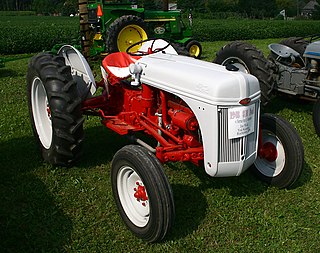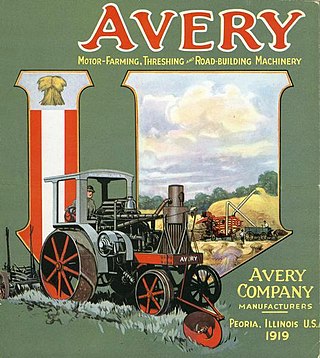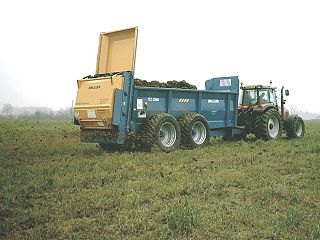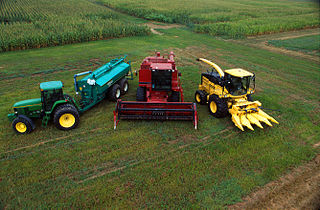Related Research Articles

A tractor is an engineering vehicle specifically designed to deliver a high tractive effort at slow speeds, for the purposes of hauling a trailer or machinery such as that used in agriculture, mining or construction. Most commonly, the term is used to describe a farm vehicle that provides the power and traction to mechanize agricultural tasks, especially tillage, and now many more. Agricultural implements may be towed behind or mounted on the tractor, and the tractor may also provide a source of power if the implement is mechanised.

Deere & Company, doing business as John Deere, is an American corporation that manufactures agricultural machinery, heavy equipment, forestry machinery, diesel engines, drivetrains used in heavy equipment and lawn care equipment. It also provides financial services and other related activities.

Allis-Chalmers was a U.S. manufacturer of machinery for various industries. Its business lines included agricultural equipment, construction equipment, power generation and power transmission equipment, and machinery for use in industrial settings such as factories, flour mills, sawmills, textile mills, steel mills, refineries, mines, and ore mills.

The Waterloo Gasoline Engine Company was the first company to manufacture and sell gasoline powered farm tractors. Based in Waterloo, Iowa, the company was created by John Froelich and a group of Iowa businessmen in 1893, and was originally named the Waterloo Gasoline Traction Engine Company. In 1892, Froelich built a successful gasoline-powered tractor, and the new company was given the opportunity to manufacture and sell the tractor Froelich designed. The tractor was not successful commercially, and of the four tractors built by the company only two were purchased, and these were later returned to the company by unsatisfied customers. In 1895, the company was sold to John W. Miller and renamed the Waterloo Gasoline Engine Company. Miller decided to stop producing tractors and instead focus on building plain gasoline engines.

The Case Corporation was a manufacturer of agricultural machinery and construction equipment. Founded, in 1842, by Jerome Increase Case as the J. I. Case Threshing Machine Company, it operated under that name for most of a century. For another 66 years it was the J. I. Case Company, and was often called simply Case. In the late 19th century, Case was one of America's largest builders of steam engines, producing self-propelled portable engines, traction engines and steam tractors. It was a major producer of threshing machines and other harvesting equipment. The company also produced various machinery for the U.S. military. In the 20th century, Case was among the ten largest builders of farm tractors for many years. In the 1950s its construction equipment line became its primary focus, with agricultural business second.

Farmall was a model name and later a brand name for tractors manufactured by International Harvester (IH), an American truck, tractor, and construction equipment company. The Farmall name was usually presented as McCormick-Deering Farmall and later McCormick Farmall in the evolving brand architecture of IH.

Yanmar Co., Ltd. is a Japanese diesel engine, heavy machinery and agricultural machinery manufacturer founded in Osaka, Japan, in 1912. Yanmar manufactures and sells engines used in a wide range of applications, including seagoing vessels, pleasure boats, construction equipment, agricultural equipment and generator sets. It also manufactures and sells, climate control systems, and aquafarming systems, in addition to providing a range of remote monitoring services.

The Avery Company, founded by Robert Hanneman Avery, was an American farm tractor manufacturer famed for its undermounted engine which resembled a railroad engine more than a conventional farm steam engine. Avery founded the farm implement business after the Civil War. His company built a large line of products, including steam engines, beginning in 1891. The company started with a return flue design and later adapted the undermount style, including a bulldog design on the smokebox door. Their design was well received by farmers in central Illinois. They expanded their market nationwide and overseas until the 1920s, when they failed to innovate and the company faltered. They manufactured trucks for a period of time, and then automobiles. until they finally succumbed to an agricultural crisis and the Depression.

Powerland Heritage Park, formerly known as Antique Powerland, is a collection of museums and a self-described heritage site for power equipment, such as farm machinery, commercial trucks, trains, trolleys, construction equipment, logging equipment, and the engines which power them. It is located in Brooks, Oregon, United States, and is operated by the non-profit Antique Powerland Museum Association (APMA). It was initially established by a group of enthusiasts "dedicated to the preservation, restoration and demonstration of steam powered equipment, antique farm machinery and implements."

A manure spreader, muck spreader, or honey wagon is an agricultural machine used to distribute manure over a field as a fertilizer. A typical (modern) manure spreader consists of a trailer towed behind a tractor with a rotating mechanism driven by the tractor's power take off (PTO). Truck mounted manure spreaders are also common in North America.
Cockshutt was a large agricultural machinery manufacturer, known as Cockshutt Farm Equipment Limited (1957–1962), based in Brantford, Ontario, Canada.

The Oliver Farm Equipment Company was an American farm equipment manufacturer from the 20th century. It was formed as a result of a 1929 merger of four companies: the American Seeding Machine Company of Richmond, Indiana; Oliver Chilled Plow Works of South Bend, Indiana; Hart-Parr Tractor Company of Charles City, Iowa; and Nichols and Shepard Company of Battle Creek, Michigan.

Agricultural machinery relates to the mechanical structures and devices used in farming or other agriculture. There are many types of such equipment, from hand tools and power tools to tractors and the farm implements that they tow or operate. Machinery is used in both organic and nonorganic farming. Especially since the advent of mechanised agriculture, agricultural machinery is an indispensable part of how the world is fed.
Oscar H. Will III, also known as Hank Will, is an American journalist, writer, and magazine editor.

Heritage Iron Magazine was founded in 2008 for those interested in muscle tractors. Muscle Tractors are a classification of tractors specifically produced from the 1960s to the mid-1980s that feature turbo, duals, and front wheel assist. Muscle tractors were a turning point in American farm mechanization when horsepower was taking over from steel wheels and crank-start tractors. This generation of tractors has been growing in popularity among tractor collectors. The magazine was founded to satiate the heritage farmer’s appetite. Heritage Iron features all brands, all makes, and all models of muscle tractors from the 1960s to mid 1980s including the equipment that the tractors used. It is published out of Greenville, Illinois, by 3-Point Ink, LLC.
National Sewing Machine Company was a Belvidere, Illinois-based manufacturer founded in the late 19th century. The company manufactured sewing machines, washing machines, bicycles, an automobile, home workshop machinery, and cast-iron toys and novelties.

The Moline Plow Company was an American manufacturer of plows and other farm implements, headquartered in Moline, Illinois, USA.
William Alexander Hewitt was the former chairman of Deere & Company of Moline, Illinois, and the last of the Deere Family to run the company. He served as United States Ambassador to Jamaica from 1982–1985.
References
- ↑ aumannauctions.com
- ↑ Vintage Tractor Digest Facebook page. https://www.facebook.com/VintageTractorDigest
- ↑ pioneerpowershow.com
- ↑ greenmagazine.com [ permanent dead link ]
- ↑ twocylinder.com
- ↑ beltpulley.com
- ↑ See the September/October 1987 issue of Belt Pulley magazine, Vol. 1, No. 6, p. 5.
- ↑ See the November/December 1987 issue of Belt Pulley magazine, Volume 2 Number 1, p. 2.
- ↑ Ibid
- ↑ See the May/June 1989 issue of Belt Pulley magazine, Vol. 3, No. 4, p. 2.
- ↑ See the March/April 1991 issue of Belt Pulley magazine, Vol. 4, No. 2, p. 14.
- ↑ See the July/August 1991 issue of Belt Pulley magazine, Vol;. 4, No. 4, p. 19 and the September/October 1991 issue, Vol. 4, No. 5.
- ↑ See the March/April 1992 issue of Belt Pulley magazine, Vol 5, No. 2, p. 15.
- ↑ See the May/June 1992 issue of Belt Pulley Vol 5, No. 3, p. 29.
- ↑ High Plains Journal hpj.com [ permanent dead link ]
- ↑ See the May/June 1989 issue of Belt Pulley magazine, Vol. 3, No. 4, p. 2.
- ↑ See the November/December 1987 issue of Belt Pulley magazine, Vol. 1, No. 6. p. 6.
- ↑ See the July/August 1991 issue of Belt Pulley magazine, Vol. 4, No. 4, p. 14.
- ↑ See the November/December 1991 issue of Belt Pulley magazine, Vol. 4, No. 6., p. 24.
- ↑ See the March/April 1992 issue of Belt Pulleymagazine, Vol. 5, No. 2, p. 32.
- ↑ See the July/August 1992 issue of Belt Pulleymagazine, Vol. 5, No. 4, p. 27.
- ↑ See the September/October 1992 issue of Belt Pulley magazine, Vol. 5, No. 5, p. 18.
- ↑ See the November/December 1992 issue of Belt Pulley magazine, Vol. 5, No. 6 p. 26.
- ↑ See the March/April 1993 issue of Belt Pulley magazine Vol. 6, No. 2, p. 33.